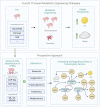Harnessing genetic engineering to drive economic bioproduct production in algae
- PMID: 38347913
- PMCID: PMC10859422
- DOI: 10.3389/fbioe.2024.1350722
Harnessing genetic engineering to drive economic bioproduct production in algae
Abstract
Our reliance on agriculture for sustenance, healthcare, and resources has been essential since the dawn of civilization. However, traditional agricultural practices are no longer adequate to meet the demands of a burgeoning population amidst climate-driven agricultural challenges. Microalgae emerge as a beacon of hope, offering a sustainable and renewable source of food, animal feed, and energy. Their rapid growth rates, adaptability to non-arable land and non-potable water, and diverse bioproduct range, encompassing biofuels and nutraceuticals, position them as a cornerstone of future resource management. Furthermore, microalgae's ability to capture carbon aligns with environmental conservation goals. While microalgae offers significant benefits, obstacles in cost-effective biomass production persist, which curtails broader application. This review examines microalgae compared to other host platforms, highlighting current innovative approaches aimed at overcoming existing barriers. These approaches include a range of techniques, from gene editing, synthetic promoters, and mutagenesis to selective breeding and metabolic engineering through transcription factors.
Keywords: algae; biofuels; bioproducts; biotechnology; genetic engineering; sustainability; transcription factors.
Copyright © 2024 Gupta, Kang, Pathania, Saxton, Saucedo, Malik, Torres-Tiji, Diaz, Dutra Molino and Mayfield.
Conflict of interest statement
SM was a founding member and holds an equity stake in Algenesis Inc. The remaining authors declare that the research was conducted in the absence of any commercial or financial relationships that could be construed as a potential conflict of interest.
Figures


Similar articles
-
Microalgae's prospects in attaining sustainable economic and environmental development.J Biotechnol. 2022 Sep 20;357:18-27. doi: 10.1016/j.jbiotec.2022.08.009. Epub 2022 Aug 12. J Biotechnol. 2022. PMID: 35970361 Review.
-
Developing algae as a sustainable food source.Front Nutr. 2023 Jan 19;9:1029841. doi: 10.3389/fnut.2022.1029841. eCollection 2022. Front Nutr. 2023. PMID: 36742010 Free PMC article. Review.
-
Whole cell microalgae: Potential to transform industry waste into sustainable ruminant feed.Bioresour Technol. 2025 Aug;430:132547. doi: 10.1016/j.biortech.2025.132547. Epub 2025 Apr 15. Bioresour Technol. 2025. PMID: 40245992 Review.
-
Algae biotechnology for industrial wastewater treatment, bioenergy production, and high-value bioproducts.Sci Total Environ. 2022 Feb 1;806(Pt 2):150585. doi: 10.1016/j.scitotenv.2021.150585. Epub 2021 Sep 28. Sci Total Environ. 2022. PMID: 34597562 Review.
-
Photobioreactor configurations in cultivating microalgae biomass for biorefinery.Bioresour Technol. 2024 Feb;394:130208. doi: 10.1016/j.biortech.2023.130208. Epub 2023 Dec 17. Bioresour Technol. 2024. PMID: 38113947 Review.
Cited by
-
Engineering the green algae Chlamydomonas incerta for recombinant protein production.PLoS One. 2025 Apr 16;20(4):e0321071. doi: 10.1371/journal.pone.0321071. eCollection 2025. PLoS One. 2025. PMID: 40238798 Free PMC article.
-
Cellular Solutions: Evaluating Single-Cell Proteins as Sustainable Feed Alternatives in Aquaculture.Biology (Basel). 2025 Jun 25;14(7):764. doi: 10.3390/biology14070764. Biology (Basel). 2025. PMID: 40723325 Free PMC article. Review.
-
Identification and Overexpression of Endogenous Transcription Factors to Enhance Lipid Accumulation in the Commercially Relevant Species Chlamydomonas pacifica.bioRxiv [Preprint]. 2025 May 7:2025.05.01.651737. doi: 10.1101/2025.05.01.651737. bioRxiv. 2025. PMID: 40655021 Free PMC article. Preprint.
-
Microalgae Bioactives for Functional Food Innovation and Health Promotion.Foods. 2025 Jun 17;14(12):2122. doi: 10.3390/foods14122122. Foods. 2025. PMID: 40565730 Free PMC article. Review.
-
Recent advances and future directions on GLA-producing organisms.Front Bioeng Biotechnol. 2025 Jul 9;13:1567840. doi: 10.3389/fbioe.2025.1567840. eCollection 2025. Front Bioeng Biotechnol. 2025. PMID: 40704100 Free PMC article. Review.
References
-
- Antar M., Lyu D., Nazari M., Shah A., Zhou X., Smith D. L. (2021). Biomass for a sustainable bioeconomy: an overview of world biomass production and utilization. Renew. Sustain. Energy Rev. 139, 110691. 10.1016/j.rser.2020.110691 - DOI

